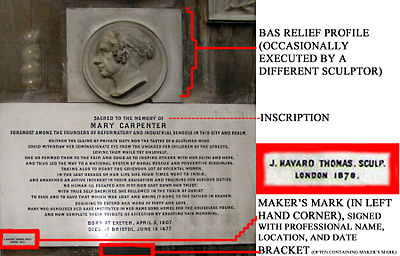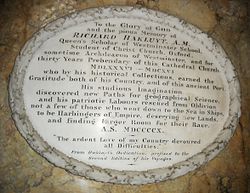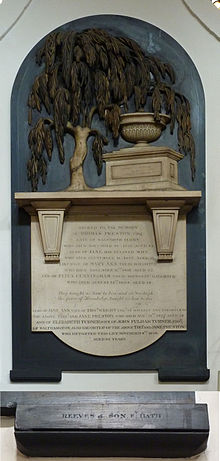- Monumental masonry
-
 An example of a signed and dated maker's mark on a wall-mounted memorial to Mary Carpenter in Bristol Cathedral sculpted by monumental mason J. Havard Thomas of London
An example of a signed and dated maker's mark on a wall-mounted memorial to Mary Carpenter in Bristol Cathedral sculpted by monumental mason J. Havard Thomas of London
Monumental masonry (also known as memorial masonry) is a kind of stonemasonry focussed on the creation, installation and repairs of headstones (also known as gravestones and tombstones) and other memorials.[1]
Contents
Cultural significance
In Christian cultures, many families choose to mark the site of a burial of a family member with a gravestone. Typically the gravestone is engraved with information about the deceased person, usually including their name and date of death. Additional information may include date of birth, place of birth, place of birth, and relationships to other people (usually parents, spouses and/or children). Sometimes a verse from the Bible or a short poem is included, generally on a theme relating to love, death, grief, or heaven.
The headstone is typically arranged after the burial. The choice of materials (typically a long-lasting kind of stone, such as marble or granite) and the style and wording of the inscription is negotiated between the monumental mason and the family members. Because of the emotional significance of the headstone to the family members, monumental masons have to be especially sensitive in their dealings with family members, especially in relation to the trade-off between expectations and cost.[1].
As a craft
Unlike the work of most stonemasons, the work of the monumental mason is of small size, often just a small slab of stone, but generally with a highly detailed finish. Generally gravestones are highly polished with detailed engraving of text and symbols. Some memorials are more elaborate and may involve the sculpture of symbols associated with death, such as angels, hands joined in prayer, and vases of flowers. Some specially-made stones feature artistic lettering by letter cutters.
Choosing a Monumental Mason
With respect to gravestone or headstone memorials, the consideration of choosing a suitable monumental mason is paramount. There are numerous masons operating, however varying in style, expertise, cost, and more importantly quality. The decision should therefore be based on the personal needs of the customer while considering: the long term outcomes for lower quality granite, reading the fine points of a particular quote, and attaining more than one quote. [2]
Monumental masons
Further information: List of monumental masons Richard Hakluyt's memorial
Richard Hakluyt's memorial
 Wall-mounted memorial by Reeves of Bath of Thomas Preston Esq. (d.1820) and wife Jane (d.1823), their daughters, and many subsequent entries. The tablet was created c.1820 but entries were inscribed until 1848. It features the willow tree motif, and is in the City of London Church of St Magnus-the-Martyr, near London Bridge.
Wall-mounted memorial by Reeves of Bath of Thomas Preston Esq. (d.1820) and wife Jane (d.1823), their daughters, and many subsequent entries. The tablet was created c.1820 but entries were inscribed until 1848. It features the willow tree motif, and is in the City of London Church of St Magnus-the-Martyr, near London Bridge.
References
Stonemasonry Types Materials List of stone • Artificial stone • Brick • Cast stone • Decorative stones • Dimension stone • Fieldstone • Flagstone • Gabions • Granite • Marble • Mortar • Sandstone • SlateTools Angle grinder • Bush hammer • Ceramic tile cutter • Chisel • Diamond blade • Lewis (lifting appliance) • Non-explosive demolition agents • Plug and feather • Stonemason's hammer • StraightedgeTechniques Products Organizations Categories:- Masonry
- Artisans
- Occupations
- Monumental masons
Wikimedia Foundation. 2010.

